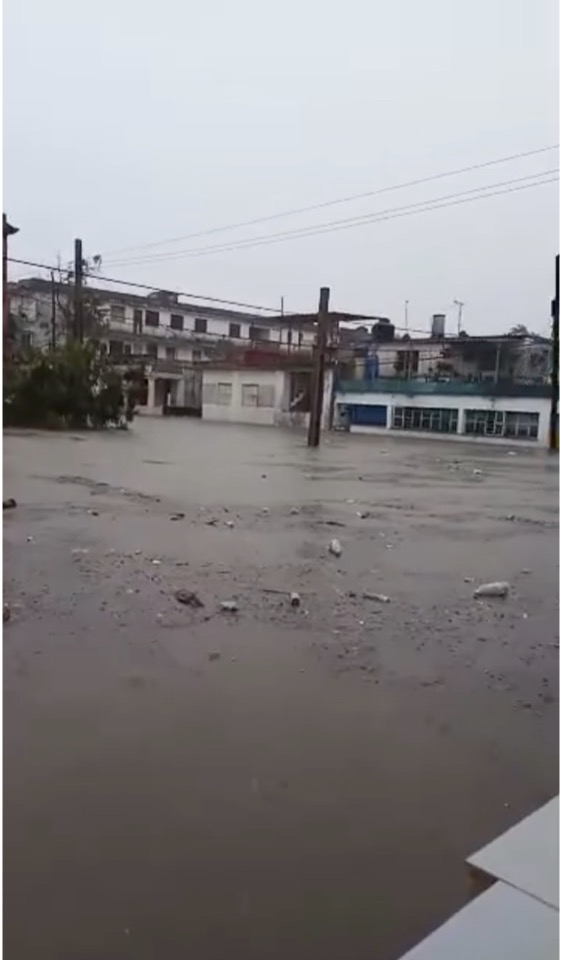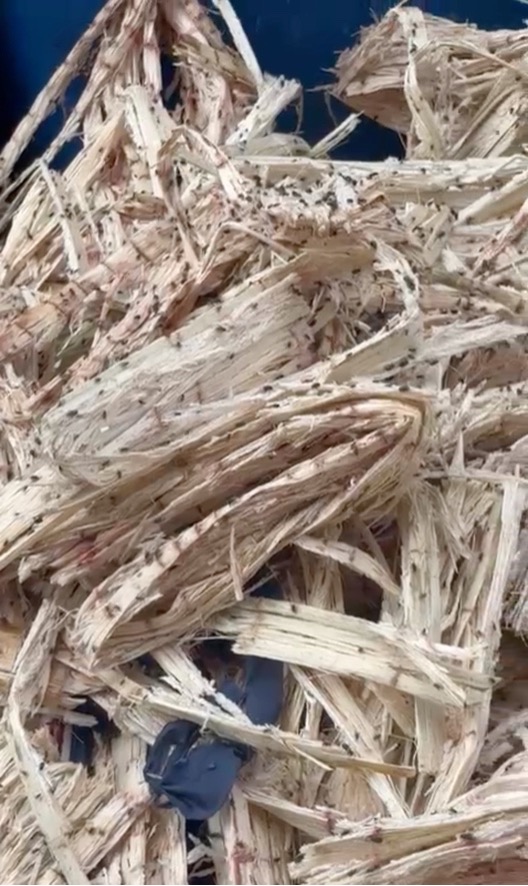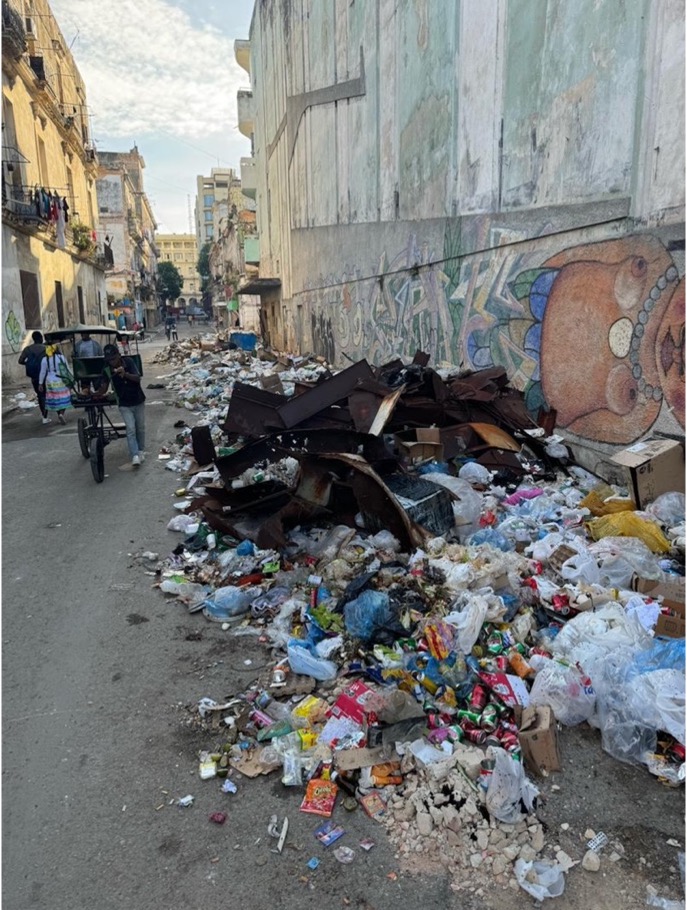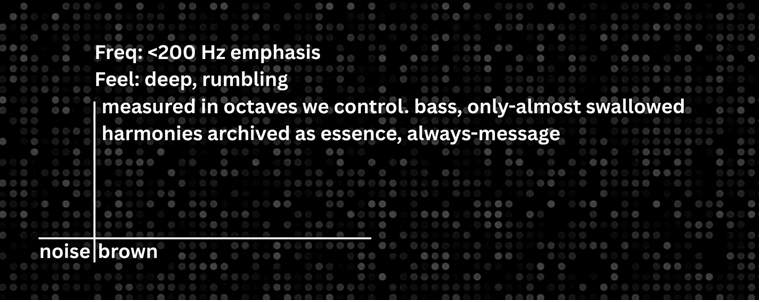Article begins
Watch Video: Havana’s Floods, Garbage & Some Poetics of Noise Colour
The image below (Figure 1) of a flood in Santos Suárez, Havana, is both familiar and endearing. The screenshot comes from a video taken from my neighbor’s porch, beside the house my mother, Afro-Cuban architect Daysi de las Nieves Veitia Santovenia, refurbished for our family in the early 1970s. Many neighbors later followed her lead, raising their walls to manage the historic floods of Zapote y Durege, where water levels could reach over six feet against the house with the green roof.

There are symbolic Afro-Caribbean ties to our former home. It once belonged to Martha Jean-Claude, the Haitian singer and actress known as the Daughter of Two Islands, who spent most of her life in Cuba. Imprisoned for her play Avrinette, deemed subversive by Haitian president Paul Magloire’s regime, she went into exile in Cuba in 1952. Santos Suárez is also where Celia Cruz was born and began singing. We may never know if Cruz ever experienced floods in Santos Suárez the way we do nowadays. Perhaps what matters more is I never saw the floods—the white noise of tropical rain, or Havana’s heavy warmth—as negative. How come?
From my Afro-Cuban vantage point, what once felt mundane—rain, flies, basura (garbage)—now reads as saturated visual and sonic residue. In this sense, the floods, garbage, and noise colors in this piece resonate with López-Labourdette, Quintana, and Wagner’s account of residues, surpluses, and waste not as discarded matter, but as potent aesthetic and political signs. These residual forms are both exterior to dominant systems and constitutive of them, exposing their limits, dependencies, and exclusions. This commentary performs what they call a “resignification of the residual,” refusing to recuperate garbage into clean legibility and instead lingering with the uncomfortable, the untranslatable, and the affectively charged.
Its poetics of “noise color” reimagine the acoustic notion—where white, brown, grey, green, or black noise are defined by frequency distribution—as a metaphor for the perceptual impact of Cuba’s socio-political frequencies transubstantiated into piles of everyday waste. In this frame, buzzing flies, flooded streets, and tonal saturation function as a critical method and an archive of Afro-Caribbean life. In doing so, the video joins Caribbean and Latin American traditions that, through the rise and fall of Cuba’s post-socialist promise, migration, persistent infrastructural precarity and the region’s broader neoliberal collapse, treat residue not as failure but as a form of knowledge and political critique. The Zapote y Durege flooded intersection, like the trash corridors and noise cards, becomes both a moment of crisis and a sensory node within the broader aesthetic of residues that define and overwhelm the Afro-Cuban experience and its sonic expressions.
The video traces such a sensory node across a sequence of sonic colors and image fragments, each paired with audio and metadata. Through brief prose poems, site-specific sounds, and a layered theoretical meditation, the essay constructs a poetics of noise color rooted in Afro-Cuban memory and diasporic resonance. The conclusion returns to the questions beginning this reflection, not to resolve them, but to invite readers to dwell with the unresolved, the interfered, the excessive, and the left behind.
Santos Suárez is a historically working-class reparto (neighborhood), now densely mixed, where Afro-Cuban families reshaped the built environment across decades of socialist urban change. Amid Cuba’s current migratory crisis, which has disproportionately emptied white and lighter-skinned middle-class sectors, Afro-Cuban families remain most visibly. Floods, garbage, and sonic residue are no longer just environmental—they mark the ongoing withdrawal of state infrastructure and care, signaling the social and political abandonment of communities like Santos Suárez. The story this text tells, though creatively framed, is ultimately about how race, class, and sonic life index one another in Havana’s barrios through deeply affective and sensory symbols of how meaning is made not despite but through the imposing noise of Cuba’s social waste. Santos Suárez’s floods and the garbage in Havana’s streets speak for themselves. Echoing Kalamu Ya Salaam, their voice embodies the sonic grammar of our diasporic landscape, from the red of post-Katrina New Orleans to Havana’s flooded greys and bursts of waste-born color.
Marc D. Perry, writing on post-Katrina New Orleans, reminds us that opacity is allowed if we remain responsible for making our stories legible. His account of Wildman Demond Francois, stranded for five days on a rooftop after the Lower Ninth Ward floods, evokes the same sense of abandonment I witness beneath the flies in Havana. The resonance is not a metaphor but an echo. The collapse of drainage, garbage collection, and housing mirrors the structural neglect Perry describes. Waterlines of disposability map both Havana and New Orleans. These images do not obscure; they hold space for the submerged, the unclaimed, and the grief vibrating beyond words.

Perhaps this is why the impetus for the video was not a sound but a question: What happens when the ordinary textures of Afro-Caribbean life, marked by my Afro-Cuban memories, are misheard as noise? (Figure 2) When rain becomes its own distortion, saturating the signal’s threshold? I turned to the sonic language of noise colors—white, brown, grey, black, and green—not as neutral profiles, but as social frequencies: distorted recognitions, muffled meanings, spectral sites of soaked rhythm. Each reveals a contested field. White flattens and overwrites, brown hums beneath perception, anchoring memory in inaudible tones. Grey is “balanced” for ears, not mine. Black—often mistaken for silence—rumbles with infrasound, ritual, protest, and grief. Green camouflages survival as serenity.

This image of juiceless sugarcane residue swarmed by flies (Figure 3) condenses the plantation’s afterlife into a silent tableau. The sweetness has been extracted, leaving behind rot, labor’s refuse, and the noise of life made invisible. In this sense, the image enacts what Antonio Benítez-Rojo calls the shift from the plantation to the Plantation: not just a historical site of sugar production, but an ongoing system. This spectral machine thrives in Cuba’s post-socialist transition and reshapes sensory life for Afro-Cubans. Flies become the buzz of disavowed histories, hovering over the ruins of extractive logics. The cane, crushed but not discarded, still transmits a faint, coded, and unresolved frequency. However, such a symbolic image of flies now driving away the imaginings of Cuba’s sweetness is not without an aftertaste. It is hard not to think about David Scott’s reflections on Sidney Mintz’s Sweetness and Power; the muted noises of our once sugar mill island continue to be the hinge linking Cuba’s Caribbean grind and foreign desires (Figure 3), rendering the way we taste as a key mechanism of our self-understanding. What if the residue of that sweetness, discarded, ignored, were, in fact, amidst all the noise of obvious decay, a signal of renewal?
Following Jennifer Stoever’s ideas, the image in Figure 4 does not represent a fixed truth, but rather a metaphor processed through the audible contours of the Afro-Cuban experience. This experience is, as Christina Sharpe names it, wake work. These fragments seek not clarity but a poetics of noise colors, naming what the dominant sensorium muffles: interruption, grief, sub-bass presence, coded insistence. Each segment pairs with a sound file and minimal metadata (freq. + feel), reducing the signal to residue. The accompanying video resists the smooth fade, built instead from rough lines, abrupt onsets, and the brief durations of various silences. Frequency and feel nod to Tina Campt’s notion of contained visual frequencies, not immediately visible, but felt, heard, sensed.

In dialogue with Robin James’ reading of Attali and Foucault, Havana’s sensory node resists the neoliberal imperative to convert all noise into signal, and what James calls the “recycling of noise” into productive surplus within biopolitical systems. While Attali’s “composition” models deregulated sonic and social intensification as neoliberal subjectivity, I return to noise not as capital, but as friction, limit, and excess. Each color here resists conversion: black noise is not derepressed silence but a pulse beyond analytics; grey, imposed legibility; white, flattening erasure. In refusing signalification—the reduction of noise to regulated, intelligible meaning—the project enacts what James calls a biopolitics of the “uncool”—here, the unresolved, unsmoothed, socially inconvenient. Floods, garbage, swarms, and sidewalk matter are not waste to be optimized into a signal, but rather sites of noise demanding slower, embodied, and often uneasy tuning.
Dorottya Mozes’s work on Black noise in Chester Himes’s The Heat’s On complements and extends this thinking by revealing how sonic practices resist aesthetic capture and racialized silence. Where James outlines the political economies of noise in neoliberal frameworks, Mozes foregrounds how Black sonic acts—breathing, whispering, screaming, ventriloquizing—trouble the threshold between legibility and disappearance. My approach similarly asserts that noise is not merely an absence or nuisance, but rather the grammar of living in and beyond racialized enclosure. By attending to textures such as guttural murmurs, ambient tension, or overloaded urban soundscapes, this work aligns with Mozes’ insight that sonic silence and discord are not opposites, but layered, affective modes of survival and refusal. The noise colors in this piece echo Himes’s soundscape: they are not about fidelity to genre or waveform, but about what Mozes calls “the multiphonic sounding” of Afro-Caribbean life, marked here by Afro-Cuban lives as a signature of Afro-Caribbean and therefore Afro-diasporic experience, coded, eruptive, submerged, and unfinished.
This conceptual framing of noise resonates with Brian D’Aquino’s reflections on Black noise as a mode of sonic insurgency resisting aesthetic sanitization, instead privileging distortion, repetition, and low-end presence as a compositional strategy and cultural memory. Like D’Aquino’s reading of hip-hop’s insurgent frequencies, I would rather dwell in a register where beat, grain, and background collapse the distinction between expression and environment. Noise here is not post-production or margin, but the pulse and frame of Afro-Caribbean audibility.
Alexander Weheliye likewise insists on the sonic as a site of Afro-Caribbean being outside the logics of racialized surveillance. Christina Sharpe reminds us that to live in the wake of slavery is to live in broken time, fractured breath, and interrupted frequencies—conditions that the video renders through signal disruptions and frequency-color fractures. Similarly, Weheliye’s theorization of a phonographic (sonic) Afro-modernity offers a way to hear these noise colors not as a deficit, but as an abundance unmeasured by dominant epistemologies. Noise is not a failure to communicate, but a surplus of meaning withheld from capture (Figure 5). The fragments in this piece are not broken—they are deliberately illegible within the metrics of signal culture. They dwell in noise colors, allowing Black island life to pulse through static, distortion, and unintended channels. What if noise is the archive? What if everything you dismissed as unreadable static was, in fact, a message you were never meant to decode?

These fragments—sonic, visual, narrative—form a poetics of noise color. They refuse to be clarified or resolved into a pattern of Cuba’s present-day social noise. They tell a story of Afro-Caribbean life, not through linear exposition, but through the layered textures of submergence and residues. What begins with rain and ends in the hum of green noise is not a closed argument but an open archive—one where memory and abandonment, signal and waste, diaspora and infrastructure vibrate alongside each other. Listening here becomes a form of reading, attuned not to what is said clearly, but to what insists in the murmur, the saturation, the unresolved.
Pablo Herrera Veitia and Darlène Dubuisson are the section contributing editors for the Association of Black Anthropologists.

